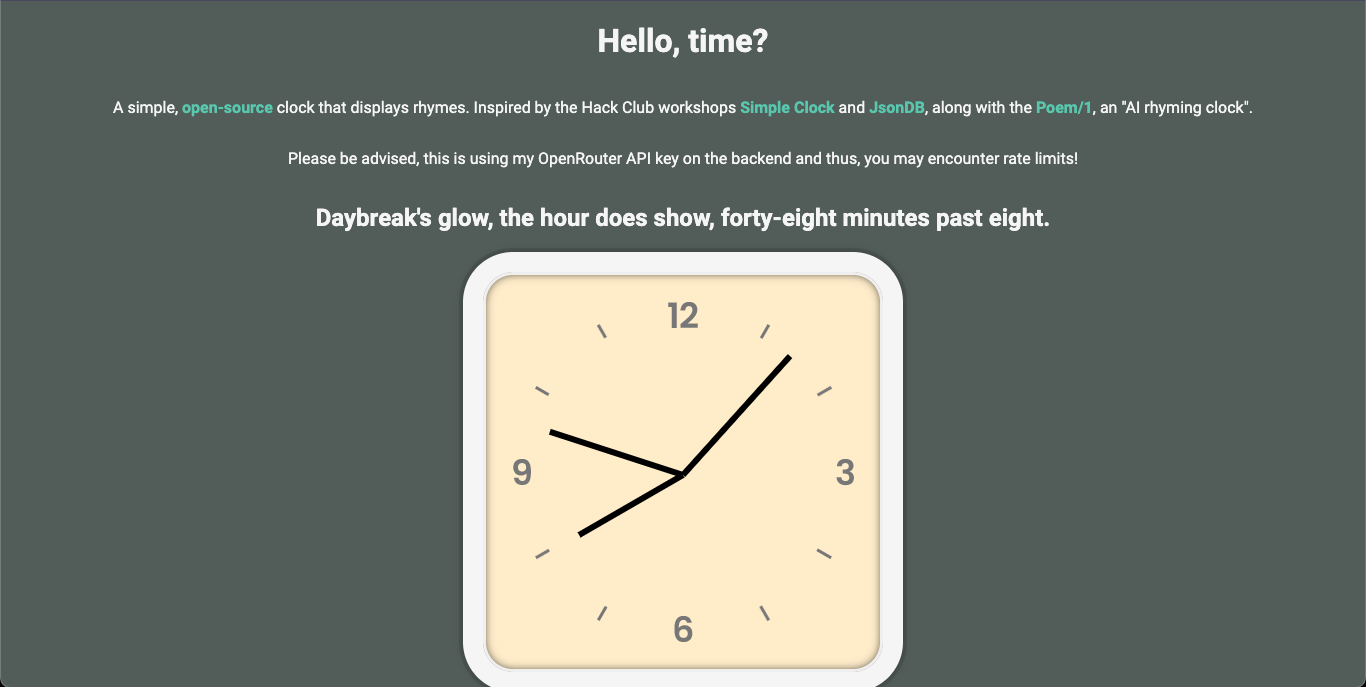TL;DR
I made my first full-stack app - a clock that displays LLM-generated rhymes/poems in addition to a normal analog clock. Check it out at clock.angad.me .
Background
I’ve wanted to learn full-stack development with JavaScript for a while. I kept putting it off, however, as I was unsure where to start. A friend of mine recommended I start with Express.js
. Hack Club
also had a workshop regarding Express.js, JsonDB
. I decided to follow this along with the Simple Clock
workshop to make a web-based clock that displays rhymes similar to the Poem/1
. For some background, the Poem/1 is a clock that displays the current time as an LLM-generated poem or short rhyme.
In the beginning, I imagined the project wouldn’t be too complex as there only needs to be a single endpoint to request a rhyme. It turned out to be a slightly more complex project, but still rather straightforward.
The back end
Following the JsonDB workshop allowed me to learn about the general structure of an Express.js application. Upon completion of the tutorial, I added rate-limiting. One aspect of full-stack projects that I like is the ability call APIs from the back end, so users are not required to provide their own API keys. This does, however, open up the door to abuse of an API endpoint. Whilst not a perfect solution, I implemented rate-limiting using express-rate-limit . After adding rate-limiting, I was able to implement calls to an OpenAI-compatible API to retrieve rhymes for a given time whilst minimizing the opportunity for abuse of the endpoint. To actually generate the rhymes, I had to iterate upon the prompt I was using, but I eventually started seeing consistent, clear responses. The only thing left was to pass the responses to the client making this a full-stack project.
The front end
The front end was rather simple to develop. The Simple Clock workshop showcased the process of creating a simple analog clock. It was a front-end only project, but it gave me the foundation needed for adding support for fetching rhymes.
Making it full-stack
Fetching the rhymes from the back end wasn’t too complex. Essentially, all I needed to do was fetch a new rhyme every minute or when the page was loaded.
To fetch a rhyme every minute, I initially checked if the second count was 0. One slightly humorous issue that this caused was extreme numbers of API calls per minute, theoretically 60 due to requestAnimationFrame being used. To make it worse, I wasn’t adding the rate-limiting middleware at the correct point in the code meaning that I was sending these requests to the OpenRouter API. Surprisingly, I didn’t encounter the limit that OpenRouter imposes on the complimentary models. After some debugging, I fortunately resolved this issue.
A disclaimer
During development, I wanted to implement a disclaimer that states that the requests to the clock may be rate-limited. Initially, I wanted to do this by comparing the hash of the set API key to the hash of my API key and if they matched, state that there may be rate limits. I quickly realized how inefficient this would because of two main reasons: firstly, the server would need to send the hash of the API key anyway; and secondly, it makes the message hard-coded and applicable to only a single API key. Thus, I did what I probably should have implemented initially: a simple call to the back end to fetch a configurable message.
Real-world usability
I was genuinely surprised how nice the project functioned, being my first full-stack project. Since it’s a webpage, it can be displayed as a live wallpaper or theoretically, even on an e-reader.
I also containerized it to ease deployment. As it’s compatible with any OpenAI-compatible API, it can be used with local models through something like Ollama
.
